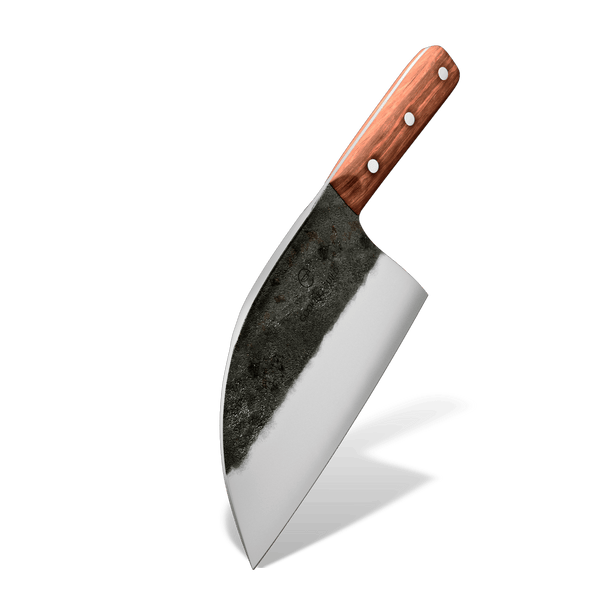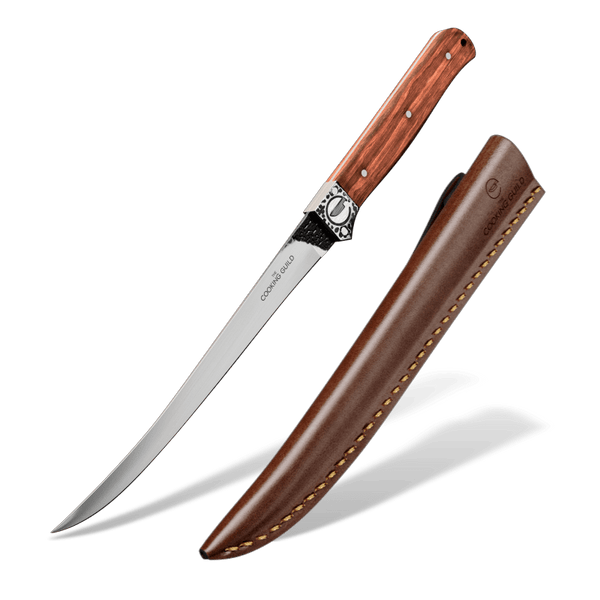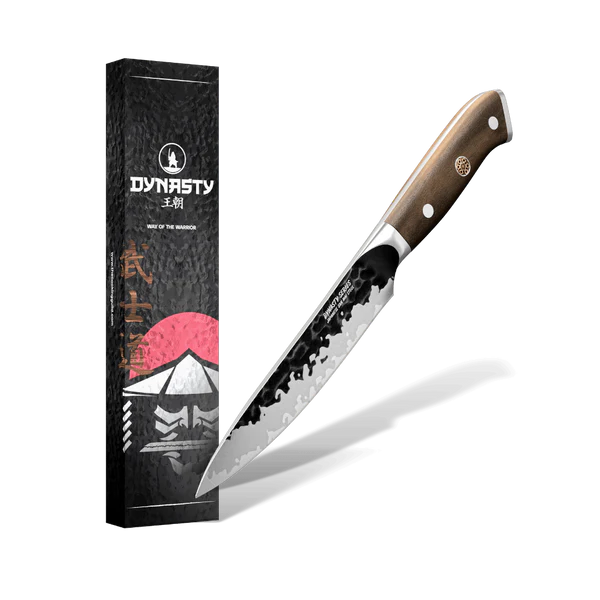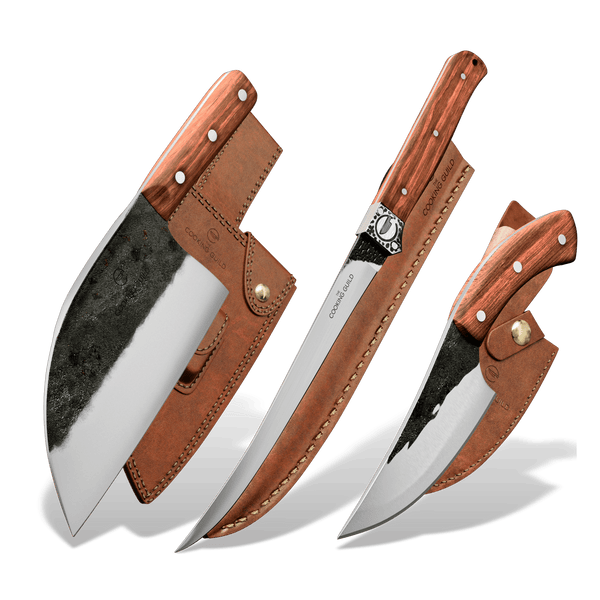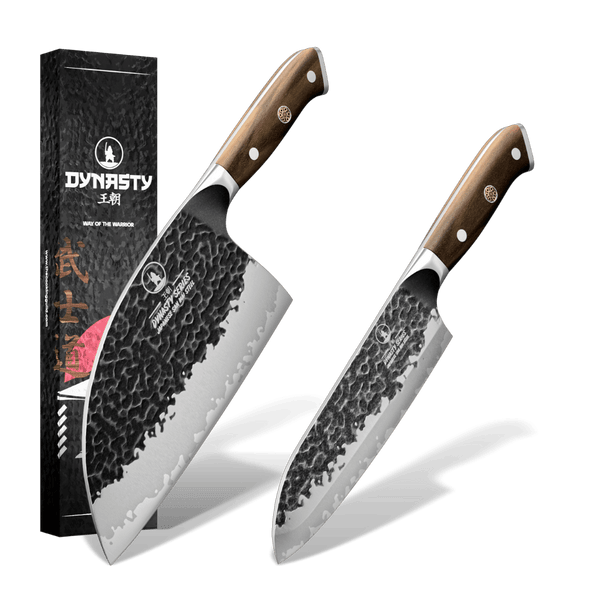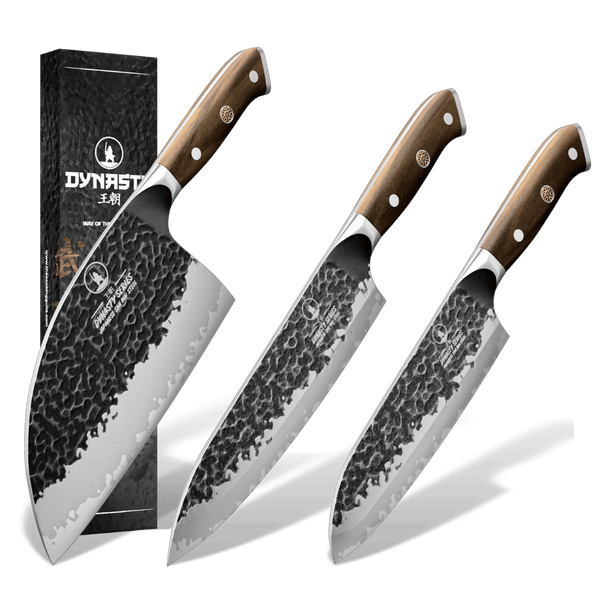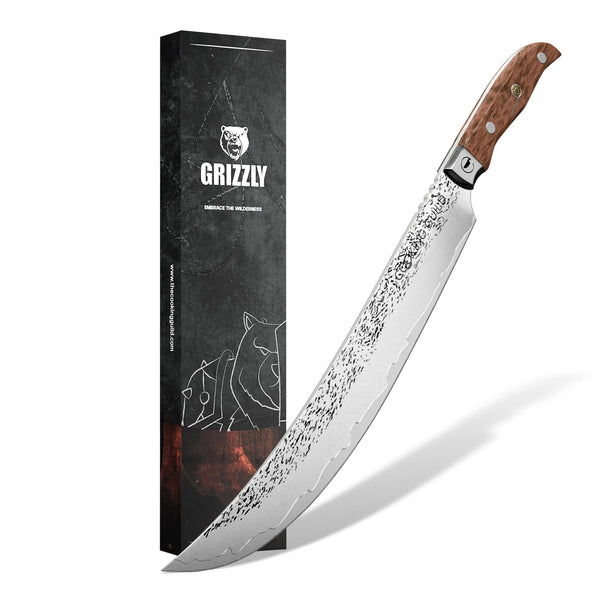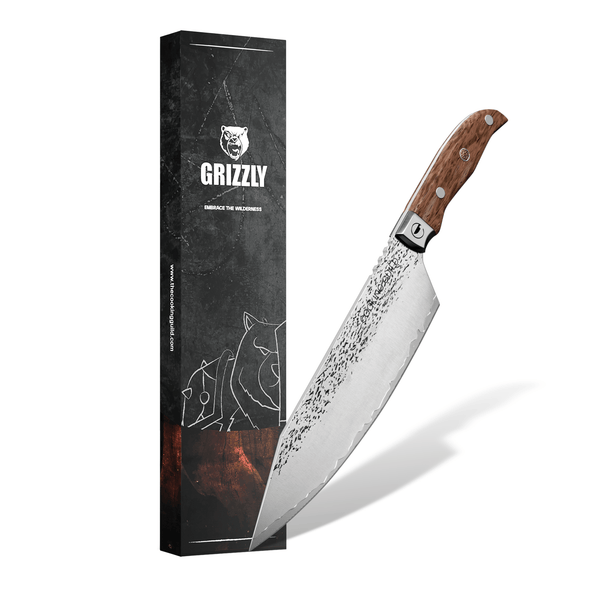The kitchen’s arsenal will never be complete without the knife. Some celebrated chefs even argue that it’s better when hand-forged than stamped. That’s debatable, isn’t it? In the end, it’s all down to one’s choice. But come to think of it, what are the best kitchen knives?
According to Red Label Abrasives, the 1.2 billion dollars per year industry has the chef’s knife as its most produced. And it's no news that forged knives are better and harder with higher blade retention than their contemporaries.
Although stamped knives make up 75% of popular demand hand-forged knives are expected to witness a 9.1% demand increase in the coming years. Therefore, now is not the best time to know all you can about bespoke hand-forged knives.
This article brings to light all you need to know about the kitchen’s most loyal utensil. Read on as I take you through the manufacturing process, differences, and features of the best hand-forged knives.
What is a Hand Forged Knife?
Technically speaking, all knives are forged. Yes, they all went through the basic processes of heat treatment, annealing, and beating into shape or case-hardening.
However, the metalsmith beats the heated piece of steel for the hand-forged knife into shape using a hammer. This comes before other sharpening processes it goes through to make it the infallible blade that we all know. You can call this the hot drop forging process.
Considering the process, you’d agree that the hand-forged knife requires a high level of craft just like any work of art. So, a masterpiece blade by a top craftsman would sport a far better balance than any other blade.
You never stop to wonder why stamped vs hand-forged knives is a hot debate topic for chefs despite the gulf in demand rates. Its simple, hand-forged knives give them the much-needed balance they crave in the kitchen. Besides, it holds an edge for a long and is much easier to sharpen.
We would go into a more detailed comparison between the two most sought-after kitchen blades. But now let’s look at the manufacturing process of a hand-forged knife.

How are Hand Forged Knives Made?
Guess you’ve seen a samurai movie where a legendary blacksmith pulls out a red-hot sword from a blazing furnace. He then beats it into shape using a hammer and cools it before doing other things to make the sword better.
The manufacturing process of hand-forged knives revolves around this same principle. Anyone who knows little about an anvil would understand the basic processes involved in forging. Thus, a hand-forged knife follows just about the same simple processes.
These include; heating the steel, hammering it into your preferred shape, and then hardening and tempering it to make it stronger.
You finish by adding a fitting handle to your new knife and sharpening the blade to make it ready for slicing.
Benefits of Hand-Forged Knives
As with all forged items, some features make them stand above other knives. Besides, most knife enthusiasts and kitchen merchants would opt for forged blades due to their resilience, durability, and toughness.
Although the quality of the blade depends on the blacksmith’s dexterity, it does have its innate beneficial attributes. That said, here are some other benefits of excellent Hand Forged Knives.
Robustness
One of the foremost benefits of a hand-forged knife is unrivaled toughness. This feature is normally attributed to the enhanced grain flow that helps to prevent cracks and breaks due to stress. Thanks to the construction, these knives retain their edge for longer.
Unlike the one-directional grain flow of machined forged knives, hand-forged blades have an irregular but uniform pattern of flow. This improves the quality of the metal and its ability to withstand wear and bends over a long period.
Variety of Shapes and Sizes
Hand-forged knives enable you to enjoy a limitless variety of shapes and sizes. Designs can vary from simple shafts and bars to rings and specialized shapes. This also takes into consideration the hardness, length and thickness of the knife. You can have a Serbian-style chef knife and folded Damascus steel.
Safety Bolster
One stand-out feature you’ll see in every hand-forged knife is the bolster. this here is one feature that endears it to every chef out there. Every forged knife comes with a bolster which is a metal mound between the blade and the handle.
This also helps to protect your hand and fingers, also prevent injuries/cuts. Thus, when slicing your veggies there’s a sort of confidence that envelops you knowing the bolster has got you covered.
Easy to Sharpen
Forged blades are not all flexible and this makes them solid and stable. This feature, which easily is seen as a drawback, makes it easy to sharpen because the blade won’t twist. Hence, when you hold it against sharpening steel or whetstone, it’s sure to remain firm.
Longevity
Once you get a hand-forged knife, you can rest assured that it’s a lifetime purchase. The fact that they are tough and resilient eliminates every chance of damage. More so, you can always restore the efficacy of its blade by constantly running it through a whetstone. So far you didn’t lose or misplaced it, this kitchen faithful is sure to serve for ages.
Drawbacks of Hand-Forged Knives
Hand-forged knives tend to be heavier than every other kitchen knife because of their unrivaled solidity. More so, due to the quality of the cutlery, it is more expensive than stamped knives.
But that’s because anyone you get will serve for a lifetime. Finally, non-flexibility which is one of its strengths may turn out to be a drawback when you want to fillet a snapper.

Differences between Stamped and Hand-forged Knives
The differences between these two high-demand knives are mainly due to their varying construction processes. The quality of the material and the expertise of the metalsmith is what makes the difference. Here are some of the variations.
Construction process
Stamped blades get their name from the making process. A machine stamps out the knife according to the preset shape from a large sheet of stainless steel.
After this comes the attaching of the handle, sharpening and polishing. But hand-forged knives go through a different complete forging process of heating, hammering, hardening, tempering, and sharpening.
Durability
The general notion that “forged is better” stems from the gulf in the durability of both knives. While hand-forged knives would last a lifetime, stamped blades tend to damage quickly. This variation again is down to the process of construction with forging making all the difference.
Safety and Convenience
The bolster on hand-forged knives helps to prevent cuts and injuries when using them. This safety measure is not stamped knives which means you can get a cut if you’re not careful.
Moreover, forged knives are easy to sharpen because they are not flexible, unlike stamped ones that may bend in the process. But this stiffness can limit the way you utilize the knife in the art of slicing. Thus, you can use the flexible stamped blades to glean.
Best Hand-Forged Knives
Even though they are every chef’s most valuable companion, hand-forged knives come in different qualities. Getting the best hand-forged knife may be a bit difficult because its superiority depends on the dexterity of the maker.
However, we have here some hand-forged knives that top the list for almost every top chef.
Best Overall - Dynasty Chef Knife

Embodying the epitome of hand-forged craftsmanship, the Dynasty Chef Knife reigns as a crowning jewel in the realm of cutlery. With a blade that's meticulously crafted through time-honored techniques, this knife stands as a testament to both artistry and functionality. From expertly slicing through delicate ingredients to confidently tackling larger cuts, the Dynasty Chef Knife emerges as a true culinary workhorse. Delve into the world of this remarkable knife, exploring its exceptional features while acknowledging its position as the best overall hand-forged knife.
Pros:
- The Dynasty Chef Knife boasts a finely honed blade that effortlessly glides through ingredients, offering unmatched cutting precision.
- From slicing and dicing to chopping and mincing, this knife's versatility makes it an all-in-one solution for a wide array of culinary tasks.
- The harmonious balance between the blade and handle ensures exceptional control, reducing fatigue during extended use.
- Hand-forged by skilled artisans, each Dynasty Chef Knife is a unique work of art, with distinct patterns that reflect its individuality.
- The hand-forged construction results in a knife of exceptional strength and longevity, designed to serve your culinary needs
Cons
- Dynasty Chef Knives are often quite expensive due to their premium materials, craftsmanship, and brand reputation. This cost might be prohibitive for some individuals who are on a tight budget.
- High-quality knives like the Dynasty Chef Knife require proper maintenance to retain their sharpness and longevity. Regular sharpening, honing, and careful washing and drying are essential. Failing to maintain the knife properly can lead to dullness and potential damage.
Best Budget - Dynasty Series Pairing Knife

In the realm of precision cutting, the Dynasty Paring Knife emerges as a true culinary gem. Crafted with meticulous attention to detail, this knife epitomizes the artistry of traditional forging techniques. From delicate tasks like peeling and trimming to intricate slicing of small ingredients, the Paring Knife proves to be an indispensable companion in the kitchen.
Pros
- The compact 5" blade offers unparalleled precision, making it ideal for intricate tasks that demand utmost control.
- The Petty Knife seamlessly transitions from peeling and trimming to mincing herbs and slicing small items, showcasing its exceptional versatility.
- Crafted through traditional forging techniques, each knife carries a unique mark of craftsmanship, with intricate patterns and personal touches.
- The compact size and balanced design allow for effortless maneuverability, reducing wrist strain during extended kitchen sessions.
Cons:
- The compact size of the 5" blade may limit its suitability for tasks that require longer strokes or working with more prominent ingredients.
- While excellent for delicate work, the Petty Knife may not be the best choice for tackling larger cuts of meat or dense vegetables.
Best Chef's Knife - Nomad Chef Knife

The Nomad Series Chef Knife seamlessly blends functionality, elegance, and craftsmanship into a kitchen essential that offers both a visual feast and a remarkable cutting experience. While its premium features and attention to detail are undeniable, personal preferences and budget considerations should also be taken into account when considering this exceptional knife for your culinary endeavors.
Pros:
- Perfect balance for precise control.
- Premium X70Cr17MoV stainless steel blade for lasting sharpness.
- Artistic design with engraved mountain range motif.
- Ergonomic handle crafted from stabilized burl wood and deep sea epoxy.
- A lifetime warranty provides peace of mind.
Cons:
- Premium quality comes with a higher price point.
- Artistic design might not appeal to those who prefer simpler aesthetics.
- Limited information on its performance in various culinary tasks.
Best Lightweight - Nomad Petty Knife

The Nomad Series Petty Knife shines as the epitome of lightweight brilliance. Its compact design and exceptional balance make it a go-to choice for those seeking a tool that excels at peeling, slicing, dicing, and shaping tasks. The knife's curved blade, skillfully forged using X70Cr17MoV stainless steel, combines durability with a touch of artistry through its sleek mountain range engraving. Not only does this engraving enhance its visual appeal, but it also testifies to the knife's commitment to both form and function.
Pros:
- Unmatched lightweight design for effortless handling.
- Premium X70Cr17MoV stainless steel blade with mountain range engraving.
- Exceptional balance for precise cutting and shaping.
- Artistic handle design for both aesthetics and functionality.
- Versatile performance for a wide range of tasks.
Cons:
- May not be suitable for heavy-duty tasks that require a larger and sturdier blade.
- Artistic handles might not appeal to those who prefer a more traditional look.
Best 5-inch - Hand Forged 5" Petty Knife

Crafted based on your most fervent requests, we spared no effort in creating a blade that surpasses expectations. This compact yet versatile knife stands as a true kitchen essential, effortlessly handling tasks from intricate peeling to precise slicing and shaping. Meticulously hand forged from premium German high carbon stainless steel, this masterpiece achieves an impeccable fusion of robust durability and surgical precision, making every culinary endeavor a work of art.
Pros:
- The 5” Petty Knife is a true jack-of-all-trades, serving as a trusty companion for various kitchen tasks.
- Crafted through meticulous hand forging, this knife is a testament to artisanal craftsmanship..
- The knife strikes a perfect balance between strength and precision, allowing you to wield it with ease.
- The blade's composition of German high carbon stainless steel guarantees top-tier strength and resistance to corrosion.
- With a 5-inch blade length, this knife is compact enough to maneuver with finesse, yet substantial enough to tackle a range of tasks.
Cons:
- While the Hand Forged 5” Petty Knife excels at numerous kitchen tasks, it may not be suitable for heavier-duty chopping or cleaving due to its compact size.
- High carbon steel demands proper care to prevent rust and maintain sharpness. Regular cleaning and drying are essential to ensure the blade's longevity.
- Some users might prefer longer blades for specific tasks or have ergonomic preferences that differ from the design of the 5” Petty Knife.
Best Design - Nomad Cleaver

The Nomad Series Cleaver Knife is more than just a kitchen tool; it's a visual delight that encapsulates founder Curtis's passion for the outdoors. The iconic blade design, reminiscent of a breathtaking mountain range, captures the essence of nature's grandeur and seamlessly blends it with the world of culinary art. This exceptional design element sets the Nomad Cleaver apart as a true work of art that graces any kitchen with its unique and captivating presence.
Pros:
- Exquisite and iconic mountain range blade design.
- Premium X70Cr17MoV stainless steel for sharpness and durability.
- Thoughtfully balanced for versatile chopping and slicing.
- Comfortable and water-resistant ergonomic handle.
- Limited-release knife, making it a unique collector's item.
Cons:
- The design-focused approach might overshadow other performance aspects for some users.
- The cleaver's size and weight might not suit all users or culinary tasks.
Best Santoku - Dynasty Santoku

Introducing the Dynasty Series Santoku Knife: a true embodiment of unmatched sharpness and masterful craftsmanship, designed to elevate your culinary experiences to new heights. As the pinnacle of precision and versatility, this Japanese Santoku Knife seamlessly blends form and function to deliver exceptional performance in every slice.
Dubbed the Japanese cousin of the chef knife, the Santoku Cooking Knife offers a unique edge in precision. Slightly smaller and lighter, this knife excels at creating precise cuts, making it perfect for intricate tasks. With its formidable sharpness and rust-resistant properties, the balanced full tang blade is a versatile tool for cutting, chopping, and dicing various ingredients. Its finesse extends to the world of sushi and sashimi, making it an excellent choice for those delicate preparations.
Pros:
- Unmatched sharpness is achieved through traditional Japanese blade-making techniques.
- Precision and versatility akin to the chef knife's Japanese cousin.
- Elegant dark rosewood handles with bespoke TCG pins for style and performance.
- High-quality blend of stainless steel for durability and corrosion resistance.
- Crafted by master knife craftsmen with two decades of experience.
Cons:
- The smaller size might not be ideal for those accustomed to larger chef knives.
- The sharpness might require extra caution during use, particularly for beginners.
- The artisanal design might overshadow specific performance aspects for some users.
Best Set - Dynasty Hero Knife Set

Elevate your kitchen prowess with the Dynasty Series Hero Knife Set, encompassing all five blades from our Dynasty Collection. This comprehensive set ensures that you're equipped with the perfect tool for every culinary task. Whether you're chopping, slicing, dicing, or creating delicate cuts, this set empowers you to conquer every culinary challenge with grace and precision.
Pros:
- Comprehensive collection covering all culinary needs.
- San Mai AUS-10 Stainless Steel for unmatched sharpness and durability.
- Carbonized rosewood handle for elegance and grip comfort.
- A lifetime warranty speaks to the collection's quality and longevity.
- Crafted using traditional Japanese blade-making techniques.
Cons:
- Premium quality might lead to a higher price point.
- The comprehensive nature of the set might not suit those who prefer minimalism.
- Requires proper maintenance to ensure long-lasting performance.
You should also check out our Steak Knives Set if you’re serious about your steak.
What To Look For In A Forged Knife
The forged knife stands as a testament to the age-old artistry that transforms metal into an instrument of culinary precision. From the meticulous shaping of the blade to the harmonious marriage of blade and handle, we unravel the elements that elevate a mere tool into a culinary companion that aligns with form, function, and finesse. Whether you're a professional chef, an enthusiastic home cook or a knife maker, understanding what to look for in a forged knife is your key to unlocking the gateway to exceptional culinary experiences.
Balance
When it comes to forged knives, balance is more than just a physical attribute; it's a pivotal factor that dictates your cutting experience. A well-balanced knife ensures that the weight of the blade and the handle align, allowing for effortless control and reduced fatigue during prolonged use. Seek a knife that feels comfortable in your hand, with a harmonious distribution of weight, enabling you to wield it with precision, whether you're dicing vegetables or carving meats.
Cost
While cost is a practical consideration, it's important to view a forged knife as an investment in quality and longevity. Superior craftsmanship and premium materials often come at a higher initial cost, but they pay off in terms of durability, sharpness retention, and overall performance over time. Opt for a balance between your budget and the quality of the knife, keeping in mind that a well-cared-for forged knife can be a lifelong kitchen companion.
Size
The size of a forged knife should align with your cooking style and preferences. Consider the tasks you perform most frequently in the kitchen – whether it's slicing, chopping, or intricate precision work. A versatile forged knife size is often around 8 to 10 inches, striking a balance between handling various ingredients and maintaining maneuverability.
Weight
Weight directly affects how a knife feels in your hand and how it moves through ingredients. A forged knife's weight should align with your comfort level and the tasks you undertake. While some prefer a heavier knife for tasks like butchering, a lighter knife is often favored for precision tasks like filleting. Experiment to find the weight that complements your techniques and enhances your cooking experience.
Bevel
The bevel, or the angle of the blade's cutting edge, affects how the knife interacts with ingredients. European-style knives tend to have wider bevels, suitable for tougher tasks, while Japanese-style knives feature narrower bevels for precise slicing. The bevel angle influences the knife's performance and should be considered based on your preferred cutting techniques.
Handle
The handle of a forged knife plays a crucial role in providing grip, comfort, and control. Whether made from wood, composite materials, or other synthetics, the handle should fit comfortably in your hand and offer a secure grip, even when wet. Ergonomics matter greatly, as they impact the longevity of your comfort during extended kitchen sessions.
Material
Forged knives are often crafted from high-carbon stainless steel, renowned for their durability and sharpness retention. This material ensures a keen edge and resistance to staining. Additionally, some knives boast Damascus or layered steel construction, enhancing both performance and aesthetic appeal. Delve into the world of steel alloys and craftsmanship techniques to select a blade that suits your culinary needs and aesthetic preferences.

Fully Forged Vs. Stamped Knives: What’s The Difference?
the choice between fully forged and stamped knives unveils a fundamental distinction that shapes both performance and craftsmanship. Understanding this difference empowers you to select the ideal tool for your culinary pursuits.
Fully Forged Knives
Fully forged knives epitomize the pinnacle of knife-making craftsmanship. Crafted from a single piece of steel, the blade is meticulously shaped through a process of heating and hammering. This technique not only enhances the blade's strength but also refines its balance, allowing for unparalleled control and cutting precision. The seamless transition from blade to handle is a hallmark of fully forged knives, ensuring optimal durability and minimizing the risk of breakage over time. With excellent edge retention and a weighty feel, fully forged knives are often the preferred choice of professional chefs and culinary connoisseurs seeking the utmost in performance and longevity.
Stamped Knives
Stamped knives, on the other hand, are manufactured through a process of cutting the knife's shape from a sheet of steel. This method, while less intricate than forging, offers its own set of advantages. Stamped knives are generally more affordable, making them accessible to a wider range of users. Their lighter weight can also be advantageous for tasks that demand quick, agile movements. While they might lack the heft and seamless integration of fully forged knives, stamped knives excel in versatility and ease of use, making them a popular choice for home cooks and those seeking efficient tools for everyday kitchen tasks.
Which One Is Better?
In summary, the choice between fully forged and stamped knives hinges on your culinary preferences and priorities. If you seek the epitome of craftsmanship and are willing to invest in a tool that marries precision with durability, a fully forged knife is your masterpiece. On the other hand, if practicality, affordability, and a lighter feel align with your needs, a stamped knife offers efficiency without compromising on performance. Whichever path you choose, both options hold a distinct place in the symphony of culinary cutlery, ready to enhance your kitchen prowess in their unique ways.
Friction Forged Knives Vs. Traditional Methods: Separating Fact From Fiction
In the dynamic world of knife production, the clash between friction-forged knives and traditional methods raises questions that deserve nuanced answers. This exploration delves into the core differences, dispelling myths and presenting facts to help you navigate this evolving landscape.
What Is Friction Forging?
Friction forging introduces an innovative twist to knife crafting, utilizing heat generated by friction to shape the blade. This modern technique accelerates the process while conserving energy, resulting in knives that boast impressive sharpness and durability. However, questions linger about the potential impact on long-term resilience and edge retention.
Common Misconceptions About Friction Forging
Friction forging, while innovative, is often surrounded by a few misconceptions that deserve clarification. One common misunderstanding is that the rapid heating process automatically results in a stronger blade. In reality, the quick heating might affect the metal's internal structure, potentially leading to variations in durability and edge retention.
Another misconception is that friction forging always produces a superior edge sharpness. While the process can indeed yield impressive initial sharpness, the long-term performance of the edge may vary due to potential inconsistencies in the metal caused by rapid heating and cooling.
Additionally, some believe that friction forging is a replacement for traditional methods. However, it's essential to recognize that both techniques have their strengths and limitations. Traditional forging boasts a proven track record of precision and longevity, while friction forging leans towards efficiency and accessibility.
Advantages Of Friction-forged Knives
One of the key benefits is their impressive initial sharpness. The rapid heating process during friction forging results in a blade that starts exceptionally sharp right from the beginning, allowing for precise cutting without an immediate need for additional sharpening.
Efficiency is another advantage. Friction forging streamlines the manufacturing process, reducing the time and energy required compared to traditional forging methods. This can potentially lead to more accessible pricing for high-quality knives.
Additionally, friction-forged knives often have a unique appearance due to the distinct heat treatment involved. The rapid heating and cooling create distinct patterns on the blade surface, giving each knife a one-of-a-kind aesthetic appeal.
Lastly, friction-forged knives can cater to a broader audience, making high-quality cutlery more attainable for a range of users. The combination of initial sharpness, efficiency, and unique design elements positions friction-forged knives as an enticing option for those seeking reliable and distinctive culinary tools.
Durability And Performance
Friction-forged knives excel in both durability and performance. The rapid heating process and unique forging technique result in a blade that possesses exceptional strength and resilience. This durability ensures that the knife can handle the rigors of various cutting tasks, including tough meats and dense vegetables, without compromising its integrity.
Moreover, the innovative forging process contributes to improved overall performance. Friction-forged knives maintain their edge for extended periods, allowing for prolonged sharpness and optimal cutting precision. This edge retention minimizes the need for frequent sharpening, enhancing the knife's longevity and usability.
The combination of enhanced durability and performance positions friction-forged knives as reliable and long-lasting tools in the kitchen. Whether you're a professional chef or a dedicated home cook, the strength and cutting prowess of friction-forged knives empower you to tackle a wide range of culinary challenges with confidence.

Unique Appearance And Feel
Friction-forged knives offer a unique visual and tactile experience. The rapid heating and cooling process during forging creates intricate patterns on the blade's surface, resulting in a one-of-a-kind aesthetic appeal. These patterns, often referred to as "Damascus" or "pattern-welded," enhance the knife's beauty and make each blade visually captivating.
Beyond their appearance, friction-forged knives also have a distinct feel in the hand. The specific forging technique can lead to a balance and weight distribution that sets them apart from traditionally forged knives. This unique sensation enhances your connection with the knife, allowing for greater control and maneuverability during cutting tasks.
The combination of a visually striking appearance and a personalized tactile experience makes friction-forged knives not only functional tools but also works of art that elevate your culinary journey. Whether displayed in your kitchen or wielded in your hand, these knives stand as a testament to the fusion of craftsmanship and innovation.
Versatility
Friction-forged knives excel in versatility, making them adaptable to a wide range of culinary tasks. Their innovative forging technique, which results in a combination of initial sharpness and durable edge retention, equips them to handle various ingredients with ease. From precise slicing of delicate items to confidently tackling tougher cuts of meat and vegetables, friction-forged knives offer a versatile tool that's ready to meet the demands of any kitchen challenge.
Whether you're a professional chef navigating a bustling kitchen or a home cook experimenting with diverse recipes, the versatility of friction-forged knives ensures that you have a dependable tool at your disposal, ready to elevate your culinary creations to new heights.
Friction Forging Vs. Traditional Methods
The debate between friction-forged and traditional knives beckons us to embrace a holistic perspective. While friction forging accelerates production and enhances initial sharpness, traditional methods emphasize heritage and a proven track record of longevity. Diving into this debate illuminates the essential factor of personal preference – the feel of a knife in your hand, the tasks you tackle, and the value you place on tradition versus innovation.
Precision
Traditional forging is revered for its meticulous, hands-on approach, resulting in knives with unparalleled precision in blade geometry, balance, and edge retention. Craftsmen meticulously shape and hammer the metal, honing centuries-old techniques. On the other hand, friction forging introduces modern technology that can achieve remarkable initial sharpness due to the rapid heating process, but questions remain about long-term precision and edge durability.
Efficiency
Friction forging takes the lead in terms of efficiency, harnessing the power of friction-generated heat to expedite the shaping process. This results in quicker production times and lower energy consumption compared to traditional forging, which involves extensive manual labor and intricate steps. Friction forging caters to a faster-paced manufacturing landscape, while traditional forging embraces a methodical, time-honored approach.
Cost
In terms of cost, traditional forging often requires more labor-intensive processes, contributing to a higher price point. This reflects the meticulous craftsmanship and time invested in producing each knife. In contrast, friction forging's streamlined approach can lead to more accessible price ranges, making it a potentially attractive option for those seeking quality without breaking the bank.
Limitations Of Friction Forging
Friction forging has some limitations to keep in mind. One concern is that the heat generated during the process can make the blade weaker over time, affecting how well it stays sharp. Also, because there's less shaping and hammering involved, the knife might not feel as balanced or work as well as those made using traditional methods. Friction forging can also lead to differences in the final knives, making them not all the same. Additionally, it might not be great for making very detailed or special knife shapes. So, while friction forging has advantages, it's important to know about these limitations too.

Why Trust The Cooking Guild?
When you choose The Cooking Guild as your knife brand, you're selecting a legacy of cutlery expertise that spans two decades. With over 20 years of experience, we've honed our craft to deliver knives that embody the perfect balance of tradition and innovation. Our thriving community of over 90,000 knife enthusiasts attests to our commitment to quality and shared passion.
Having proudly sold over 150,000 knives, our track record speaks volumes about the trust we've earned. Each blade is a testament to meticulous craftsmanship and an unwavering pursuit of excellence. The Cooking Guild knife brand isn't just a product; it's a journey, an investment in your culinary dreams.
Case Studies: Forged Knives in Action
Let's delve into the world of friction-forged knives through these remarkable case studies.
Ferrum Technology's Precision
A trailblazer in the world of high-performance knives and kitchen tools, Ferrum Technology are knife makers that utilizes friction forging to craft its coveted Ferrum Reserve knife line. The inherent properties of friction-forged steel, including exceptional strength and resilience, position these knives as high-performance tools with enduring sharpness. What sets them apart is the tight grain structure of friction-forged steel, delivering not only a keen edge but also remarkable edge retention over time.
Chris Reeve Knives' Craftsmanship
Enter Chris Reeve Knives, a brand synonymous with top-quality folding knives. Their Sebenza line stands out by integrating friction forging, resulting in blades adorned with a captivating "Raindrop" pattern that seamlessly blends aesthetics with functionality. Collectors and outdoor enthusiasts alike have been captivated by the durability and performance of these friction-forged knives, showcasing their exceptional blend of artistry and utility.
Final Word
Getting a hand-forged chef’s knife is a bold step towards an exciting cooking experience. But when it’s a hand-forged knife, you get much more than amazing cooking time. You can enjoy unrivalled durability, sharpness, and toughness with any of the best hand-forged knives.
FAQs
What Are The Benefits Of Forged Knives?
Forged knives stand as the pinnacle of knife-making artistry, boasting a host of unrivalled benefits that elevate your culinary experience. Crafted from a single piece of steel through meticulous heating and hammering, these knives offer exceptional strength, balance, and cutting precision. The seamless blade-to-handle construction ensures long-lasting durability and minimizes the risk of breakage. With superb edge retention and a weighty feel, fully forged knives provide professional chefs and cooking enthusiasts alike with unparalleled performance and longevity.
Are Forged Knives Worth It?
While they might come at a higher cost, the unmatched craftsmanship and lasting quality make forged knives an essential choice for both professional chefs and dedicated home cooks. With each use, you'll find that the investment in a forged knife translates into a lifetime of culinary excellence and unmatched satisfaction.
Is A Forged Blade Better?
Yes, a forged blade is better. It's made carefully to be strong, well-balanced, and great at cutting. Even though it might cost a bit more, you get a chef’s knife that lasts and works well in the kitchen.
Are Forged Blades Stronger?
Forged blades are indeed stronger. They're crafted from a single piece of metal that's carefully shaped and hammered. This special process makes them tougher, so they can handle tough jobs in the kitchen, like cutting through meat and bones. They won't bend or break easily, which means they stay strong and reliable for a long time.
